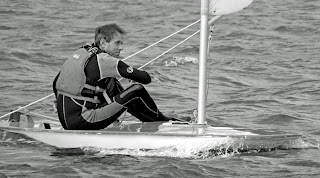It's always heartwarming to see a dinghy class experiencing a modern day revival, particularly when that class is a scow, a type that is one of my favorites. Rupert Whelan is the kingpin in resurrecting the Minisail scow in England and he has sent me some photos and a report. (Boy, do I love it when someone sends post ready material to Earwigoagin!)
The Minisail was Ian Proctor's first scow design, the forerunner to what would be the worlds most popular scow design, his rotomolded Topper scow with over 50,000 built so far. The idea for the Minisail was germinated when Ian observed the Yanks and their first beach boats (probably the lateen rigged Alcort Sailfish) on a trip to the U.S as a reporter for the 1958 America's Cup. (There is a certain symmetry here. The Sailfish would eventually be developed into the more popular Sunfish with over 250,000 boats built. The Minisail would be eventually developed into the more popular Topper with over 50,000 boats).
Here are the Minisail specs from the advertising brochure of Richmond Marine.
Unlike the Americans who love to keep things the same, Ian Proctor and his builders were always tinkering with the Minisail and there were several variations produced. Rupert outlines the history.......
"The Minisail was designed by Ian Proctor in 1959 after a visit to the USA, where he saw the early Alcort
beachboats and decided to design one for British waters. The first design was flush decked, round bowed
with a slight V bottom. This became the Monaco MkI. These were mainly built in GRP.
In order to make home building in wood easier, he designed a flat bottomed version, called a Sprite. This has a square
bow with a carry handle built in, so they are easily distinguishable.
For more comfortable sailing on flat water, Ian Proctor designed a cockpit version of each design; these became the Monaco and Sprite
MkIIs. All this development took place over a short period in the early 1960’s. Whether the boat had a
sliding seat, or even wings, was a personal choice, with most of the boats which raced having some sort
of sitting out aid.
In the early 1970’s an experiment was made with a Monaco hull, making it self draining, and the
Minisprint was born. The Minisprint MkII was soon created, which was GRP, self draining, with built in
seat support, a pivoting centreboard and a larger section boom with tracked foot, rather than the loose
footed sail other Minisails had, in order to control sail shape better.
Just before the Minisail faded away, a composite version of the Minisprint was designed, called the Meson but very few were built."
More information can be found over at
the Minisail website.
And some pictures (click in the picture to start a slideshow, photos courtesy of Karen Collyer)..............
Fleet of four Minisails, all different versions, at the Classic, Vintage Racing Dinghy Nationals. Leftmost is Tom Moore in a home built Minisprint, Rupert is front and center with his wooden Sprite, blue and white sail is Peter Matthews in a Monaco Mk1 and David Argles in a GRP Minisprint MKII.
Peter Matthews in a flush decked Monaco MKI.......
Tom Moore in a home finished Minisprint with a sliding seat.......
Part 2 of this post on the Minisail can be found
over here .























